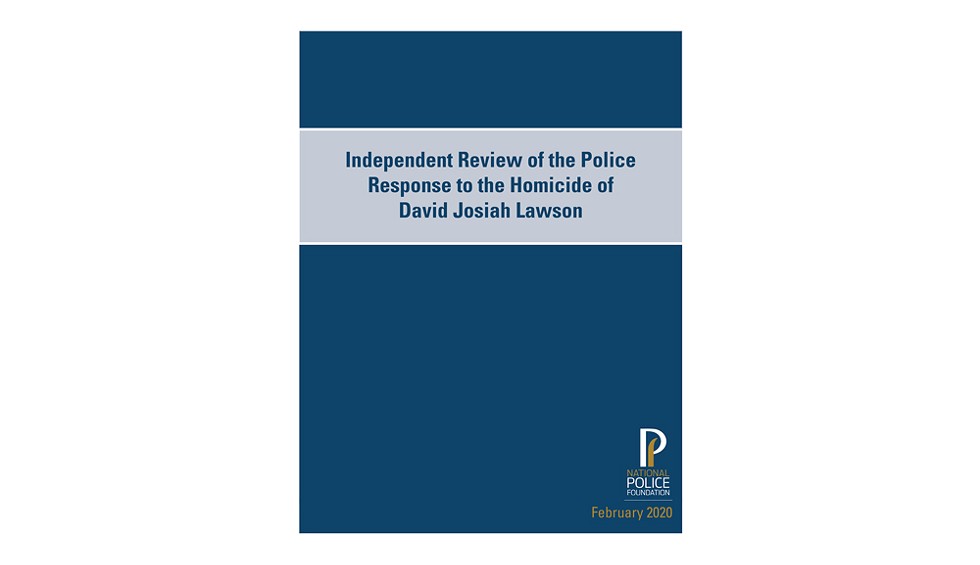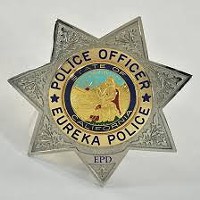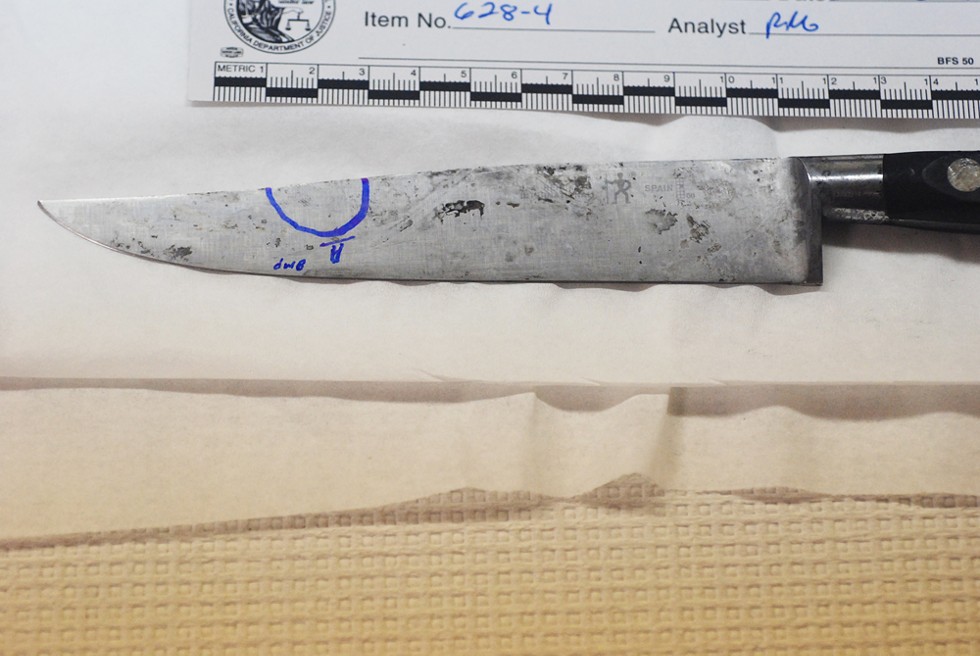'Organizational Failures'
Report details the missteps, errors and leadership void that crippled the Lawson homicide investigation in its first 72 hours
By North Coast Journal Staff
The National Police Foundation report spans 67 pages and is sharply critical of the Arcata Police Department leadership's handling of the David Josiah Lawson homicide investigation.
[
{
"name": "Top Stories Video Pair",
"insertPoint": "15",
"component": "17087298",
"parentWrapperClass": "fdn-ads-inline-content-block",
"requiredCountToDisplay": "1"
}
]
The commanding officer who oversaw the first steps in the Arcata Police Department's probe into the April 15, 2017, stabbing death of David Josiah Lawson had no specialized training in crime scene management or homicide investigation. The officer tasked with photographing the crime scene used a point-and-shoot camera, had been working in law enforcement less than a year and had never investigated a killing before; the only evidence collection training he'd received was in the police academy. The detective who ultimately took control of the scene and the investigation had never been the primary investigator on any case before, much less a homicide, and was promoted to the position as he was called out to the scene.
Compounding that lack of experience was the fact that none of the department's top brass — not its chief of police, operations lieutenant or detective sergeant — made it to the crime scene that morning. In the absence of their leadership, officers made multiple, crucial, irrevocable errors, from failing to adequately secure the crime scene to letting key witnesses leave the scene, in at least one case after giving contradictory statements about the stabbing.
A succession of decisions — from budget cuts and staffing levels to training priorities and even who should respond to the scene that morning — "resulted in a series of organizational failures, tactical missteps, and investigative and leadership errors, which have damaged the investigation and marred the department's reputation and credibility in many areas of the community," the report states.
Those are some of the key findings in a highly anticipated report from the National Police Foundation analyzing APD's initial response to Lawson's killing. The foundation — which city officials first expected to complete the report in late 2018 — is a nonprofit, non-partisan police research organization that works to "progress democratic policing strategies" and "helping policing enhance community trust and confidence." Because the foundation is staffed primarily by former officers, some locally expressed concern the report wouldn't look at APD's conduct critically. But the report — while lauding first-responders' efforts to save Lawson's life that morning — is at points scathing when detailing APD's missteps in the first 72 hours of the Lawson investigation.
"During this review, the NPF assessment team found that APD officers responded quickly and professionally to a highly chaotic scene — an event that would have been challenging for any agency of any size and sophistication," the report states. "APD first responders focused their attention on providing lifesaving measures at the highly-charged scene. However, Arcata had not provided the appropriate level of organizational leadership, planning and training to respond to, and investigate, this type of complicated and chaotic homicide scene. Many of the basic tenets of crime scene security and management were not followed."
The report's release offers the public its most complete glimpse yet into APD's response to the scene of Lawson's death. Relying on dozens of interviews, hours of audio and video recordings from responding officers, dispatch records and call logs, a team of National Police Foundation investigators reconstructed APD's initial response that morning and have issued three dozen recommendations on how the department can be better prepared in the future.
The report comes as the third anniversary of the 19-year-old Humboldt State University sophomore's death approaches, with his killing remaining Arcata's only open homicide case. It details what officers faced when they responded to a report of a stabbing at about 3 a.m. April 15, 2017, at an off-campus party on a cul-de-sac off Spear Avenue to find Lawson bleeding from multiple stab wounds and a chaotic scene with more than 100 people. Police arrested a McKinleyville man, Kyle Zoellner, at the scene and he was charged with Lawson's murder, but the case was thrown out of court 16 days later, when a Humboldt County Superior Court judge ruled there was insufficient evidence to hold him to stand trial. The case then went back to the Arcata Police Department for further investigation. The Humboldt County District Attorney's Office convened a criminal grand jury in February of 2019 to consider evidence in the case — including new DNA evidence from a knife recovered at the scene — but it declined to hand up any indictments in the case, once again returning it to APD.
APD Chief Brian Ahearn, who took over the department in late 2018 just as former interim Chief Richard Eahle submitted the Lawson case to prosecutors for a second time, told the Journal flatly that APD owns its mistakes and will work diligently to implement each of the foundation's 36 recommendations. In the meantime, the department will continue working to track down witnesses and solve Lawson's killing.
"We're never going to stop investigating this case until we get back in court," he says.
In the days immediately following Lawson's death, a public narrative formed — largely due to media reports that relied almost exclusively on statements from one of Lawson's friends — that the emergency response that morning had been uncaring and unprofessional, hampered by biased police officers who did not perform first aid and appeared more concerned with controlling a group of distraught people of color than saving the dying Lawson. The foundation report indicates this is flatly false and commends first responders for doing all they could to save Lawson's life.
At 3:01 a.m. on April 15, 2017, the California Highway Patrol received its second 911 call from a residence in the 1100 block of Spear Avenue. The first had reported that it appeared a fight was about to occur. This caller said someone had just been stabbed twice — "once in the chest and once in his ribs" — according to the report. A little less than two minutes later, APD officers were dispatched to the scene.
Officer Devon Nilsen was the first to arrive, showing up just seconds after the call went out over the radio. He was immediately directed to Zoellner, whose face was bloodied and battered, and whom partygoers had identified as the suspect. Nilsen handcuffed him and put him in the back of his patrol car.
"Recognizing the tense crowd that was forming, and as guided by officers' training and standard protocol, the officer remained in the proximity of the patrol vehicle with the detained subject throughout the rest of the incident to ensure the safety of the suspect," the report states.
Officer Jacob McKenzie arrived just about a minute after Nilsen, according to the report, in time to see him leading a cuffed Zoellner to his patrol car. Officer Krystle Arminio, the watch commander, arrived less than a minute later and was directed to Lawson. By the time she reached his side, McKenzie was already there and the two began life-saving efforts, with McKenzie applying pressure to Lawson's wounds and Arminio doing CPR.
"Despite the charged scene, based on the audio recordings, it appears that the two APD officers were continuously engaged in the life-saving efforts for the victim during this initial response," the report states. "The recording indicated that the officers were on the ground with the victim continuously until the firefighters and paramedics arrived. The audio recordings indicated the officers were focused on the victim even while they were surrounded by numerous agitated and emotional partygoers."
The first fire truck arrived at the residence at about 3:10 a.m. from the Mad River station, according to the report, and the fire captain assessed Lawson, determining he had to be moved from a "cramped and grassy area" to a place where they could better work on him. According to past Journal reporting, the firefighters briskly pulled Lawson from the bushes, which appeared rough, and further riled the distraught crowd.
"The firefighters reported that they were pushed and shoved by persons in the crowd as they tried to move the victim to a more advantageous place to continue their rescue and medical aid to the victim," the report states. "An agitated man shouted to them, 'You're doing it wrong!' His comments enlivened others who had crowded around the area. The AFD captain who was attending to the victim later reported that the anger and tension in the crowd made her feel threatened for herself and her crew."
Arminio stepped in to try to keep the crowd at bay, according to the report.
An ambulance arrived on scene at 3:15 a.m. and was cleared to immediately enter the driveway without staging.
"The crowd became confrontational a second time when the victim was placed on a gurney and into the ambulance," the report states. "A firefighter and emergency medical technician were in the back of the ambulance with the victim. One of the victim's friends attempted to enter the ambulance to travel to the hospital with them. He was not allowed in the ambulance but held onto the door so it could not be closed. By the end of the encounter, which lasted approximately a minute, fire personnel pushed the subject away from the door, allowing it to be closed and allowing the ambulance to depart. The ambulance was en route to the Mad River Community Hospital with the victim approximately 17 minutes after the APD officers were dispatched to the call."
Lawson, who arrived at the hospital with his heart still beating, was pronounced dead at 4:07 a.m.
"Allegations have been made questioning first responding officers' compassion for the victim and their willingness to provide aid," the report states. "Their actions have been described in the media and by some in the community as 'lackluster and uncaring.' ... Despite these narratives ... audio and video evidence, as well as interviews with witnesses, indicate that the initial actions by first responders demonstrated an appropriate focus on life-saving measures and public safety. The NPF assessment team found that the initial arriving officers made remarkable efforts to fulfill law enforcement's primary mission — to provide immediate life-saving efforts and first aid to the victim and arrest the suspect identified by witnesses at the scene — in the interest of public safety."
The report faults former Arcata Police Chief Tom Chapman for not releasing more information and acting more assertively to counter the false narrative, saying a number of city leaders had asked Chapman to do so.
"He declined, thinking, 'It will go away,'" the report states, adding that Chapman had also contributed to some of the misinformation circulating in the community by erroneously telling Lawson's mother, Charmaine Lawson, that the ambulance had to stage near the scene because of an unruly crowd, delaying medical aid to her son. "Thus, misinformation without immediate correction from the APD enabled those on social media and other platforms to influence the public narrative around the response, portraying the first responders to the incident as uncaring and unprofessional. These allegations and questions ... have continued since the incident."
The report recommends APD be more aggressive about releasing information and countering false public narratives in the future. Additionally, the report notes that a consolidated public safety dispatch center — one that routes all calls for service through a single center used to dispatch multiple agencies — could increase efficiencies in emergency response, though it could come with considerable costs.
The fact that calls in the Lawson case were initially routed through CHP before landing with APD, Arcata Fire and Mad River Ambulance ultimately added minutes to the response times.
If APD officers' efforts to save Lawson's life were "remarkable," things quickly fell apart when they transitioned into an investigative capacity, according to the report. As the senior officer, Arminio was in charge of the scene but had never received specialized training in crime scene management, and didn't initiate a critical incident command protocol that would have given everyone at the scene specific tasks.
The report also notes that while experienced officers from other agencies were at the scene that night — including two CHP officers, two Humboldt County Sheriff's Office deputies and a sergeant, and an officer from the University Police Department — there were no established protocols in place that allowed them to step in without direction to secure the crime scene or contact witnesses. And Arminio apparently wasn't aware that existing inter-agency agreements would have allowed her to direct them to do so.
One of the first things officers did after the ambulance departed for the hospital with Lawson was attempt to secure the crime scene but, again due to a lack of experience, Arminio directed officers to tape off only a small area of the cul-de-sac.
"(Arminio) assumed that the crime scene was limited to the width of the driveway area and that the stabbing had occurred where she observed a pool of blood," the report states. "However, the stabbing had not occurred in the driveway, but on the adjacent lawn area. ... Numerous people had unfettered access to the crime scene after the ambulance and the victim's friends left the scene."
Officers also failed to secure Zoellner's car as part of the crime scene, later allowing an acquaintance to take it home before it had been searched or processed for evidence.
Shortly after Lawson was transported to the hospital, Arminio found a knife under a car parked in the cul-de-sac and, suspecting it may be the weapon used in the stabbing, decided it should be photographed and collected as evidence. The officers huddled together, according to the report, and "debated how they were going to photograph the knife since they did not have 'city issued phones.'" It was decided McKenzie would use a department-issued point-and-shoot camera to document the scene, including the knife.
The report captures an exchange that to some extent illustrates the officers' lack of experience investigating violent crime. While Arminio initially thought the knife she found had likely been used to stab Lawson, she later debated that, saying, "There's no blood on it," apparently not having "considered or discussed the possibility that the knife had been wiped off or moved by a third party."
Just a few years prior, the Arcata Police Department's full-time evidence technician would have been dispatched to process the scene, taking photographs and collecting evidence. The position was eliminated, however, due to budget cuts. (It has since been restored by Ahearn as a part of an investigative team assembled to respond to all major incidents.)
"Crime scene processing and evidence collection responsibilities were spread throughout the agency without commensurate training, supervision and management oversight," the report states, which left McKenzie to rely on his academy training to process a homicide scene for evidence.
But perhaps the most egregious missteps that morning came with regard to potential witnesses. The report notes that reviews of videos from the scene show "the officers on scene were concerned with clearing people from the chaotic scene rather than identifying witnesses. They did not delegate responsibility to gather and identify witnesses and triage from the most crucial, to other officers who were present. ... Minimal attempts were made to detain or identify parties that may have been involved in the altercation or who may have witnessed the incident. Key witnesses and potential suspects were allowed to leave the scene or communicate with one another."
The most egregious example of this is the officers' handling of Zoellner's girlfriend, Lila Ortega, and the three friends she'd attended the party with. To some extent, all had been involved in or witnessed the multiple fights that had preceded Lawson's stabbing, but the officers made no attempts to separate them to keep them from aligning their stories.
"The first and second responding officers conducted informal interviews of the female associates at different times at the scene on Spear Avenue," the report states. "It does not appear that the officers coordinated efforts or communicated any of the information received with one another. No attempt was made to preserve the integrity of their statements by separating the women or having them transported to the police department for interviews despite their indication that they had been involved in the altercation."
The report notes that one of the women — whom the Journal identified as Angelica McFarland by cross-referencing information from the report with testimony from Zoellner's preliminary hearing — gave officers three conflicting accounts.
"[McFarland] told an officer that she saw the stabbing and that she saw a black man attack the suspect, who attempted to wrestle the knife from him," the report states. "According to her statement, the man then stabbed the victim and walked away. ... [another summary] included information obtained from the same witness by another officer within minutes of the first interview, which indicated that she had not seen the stabbing. The same witness was interviewed by a detective two additional times. Each time the witness provided a different statement about the incident and their involvement."
Official investigative reports summarized McFarland's statements and failed to address the inconsistencies, with one saying simply that she said the "arrested suspect never had a knife and never stabbed anyone," according to the National Police Foundation report.
In another instance, officers reported a crucial interview inaccurately in their reports, indicating a potential witness to the stabbing had positively identified Zoellner as Lawson's assailant when he'd only provided a description that vaguely matched the suspect. The officers also didn't address that the witness' account was directly in conflict with that of another witness.
"In addition to the incorrect summation, the review of the interview audio recording revealed that the detective did not ask substantive follow-up questions of what appeared to be a key witness," the report states. "The appropriate follow-up questions would have included a detailed description of everything the witness saw and did not see."
While most of the mistakes at the scene can be attributed to a lack of training, experience and supervision, it's harder to square the report's evaluation of Zoellner's official interview that morning. It was conducted by Detective Sgt. Todd Dokweiler, a seasoned homicide investigator, at the Arcata Police Department. But according to the report, Dokweiler hadn't been to the crime scene or reviewed any digital photographs prior to the interview with Zoellner, and it's unclear to what degree he'd been briefed on other witness statements to that point.
"The arrested suspect was cooperative and answered the detective sergeant's questions," the report states of the interview, during which Zoellner said he'd been knocked unconscious early in the fight and had no recollection of what had happened, though he said he would never stab someone. "The interview could have yielded significant information but it lasted only approximately 15 minutes and was curt instead of exploratory. The arrested suspect did not refuse to answer additional questions."
When responding officers recognized the gravity of the scene they'd responded to the morning of April 15, 2017, they followed protocol and notified the chain of command. At about 3:46 a.m., Arminio notified the operations lieutenant and Dokweiler. But the operations lieutenant was on a scheduled vacation and — apparently — no plans had been made for another commanding officer to be on call. The operations lieutenant called Chapman, who opted not to respond to the scene.
This is indicative of the pervasive lack of leadership in this case, according to the report, which notes the void extended from training and preparation, through management of the crime scene that morning all the way to case review and quality control. According to the report, nobody took an active role in case review and oversight at the command level in the early weeks of the investigation, before the case was presented to the Humboldt County District Attorney's Office or even after it came back to APD following the preliminary hearing.
In an interview with the National Police Foundation team, Chapman indicated he'd initially believed the case to be "fairly straightforward," according to the report. It's unclear exactly why, but the report also notes that Chapman refused multiple agencies' offers to assist with the investigation. Despite not having conducted any case review, he reportedly felt that with a suspect identified, his department had the case under control.
"In retrospect, he understood both he and the operations lieutenant should have been more involved in the oversight of the investigation at the beginning, saying, 'I should have been more in the weeds,'" according to the report. "Despite not conducting a case review, the chief felt that there was sufficient evidence to have the subject held to answer in the preliminary hearing. The chief only later realized, 'In hindsight, we weren't ready.'"
But this lack of internal review continued all the way up to when the foundation began working on this report in 2018.
"Until this independent review process began, the APD had not taken the opportunity to debrief this incident internally to glean learning points that could be incorporated throughout the department," the report states. "An opportunity was missed to carefully examine the challenges presented in this investigation and learn from them."
It's hard to calculate to what degree the many missteps have undercut the investigation into Lawson's killing. The report notes that officers' push to disperse witnesses from the scene that morning, coupled with the narrative of a biased response that circulated through local media in the days following the killing, have caused some witnesses to be reluctant to come forward.
Ahearn told the Journal that so far the department has only been able to interview about 30 witnesses to date, when there were at least 100 people at the party and as many as 300 by some estimates. But just earlier this month, Ahearn said a new witness came forward and provided valuable information. And ultimately that seems to be the only route forward in solving this case, as the state of the forensic evidence — which reportedly found a drop of blood on the knife with DNA from both Lawson and Zoellner — wasn't enough to sway a grand jury into issuing an indictment.
And Ahearn said APD is steadfast in its resolve to implement each of and every one of the report's 36 recommendations. Some have already been incorporated, some are in process and others, he notes, will mean having some tough conversations with the community.
"That's our commitment to Charmaine, to our community and our department," he said.
The report also makes clear that this case drove a wedge into what was already a gap between the campus and the community, between people of color and their police department. There were already stories of bias and hard feelings, and this case — which, according to preliminary hearing testimony, saw a white woman yell, "I hope that nigger dies," as a black man lay bleeding to death after allegedly being stabbed by a white suspect — amplified those. The misinformation that circulated after Lawson's death, coupled with the litany of mistakes made by APD, now leave a steep hill to climb toward reconciliation and trust. Though the report found no actual evidence of bias in APD's response that morning, it makes clear the department must recommit to community policing principles and working to forge a tighter bond with the community it serves.
"The fact that people believe the response was somehow influenced by race we will never try to minimize," Ahearn said. "Our job is to acknowledge that and work very hard to let people know that is not who we are as an organization. We take responsibility for the mistakes that were made. We own those mistakes and our commitment, if we haven't already fixed it, is to fix it and collectively, as an APD family, to never let that happen again."
For her part, Charmaine Lawson says she hasn't been able to bring herself to read the report. Not yet. It's just too raw and too emotional to see her son's name next to the word "murder."
"I can't do it," she said, adding that she's thankful it's out there and hopeful APD follows its recommendations. "I'm grateful (City Manager Karen) Diemer made the report public and sent it out to the community. APD definitely messed up and botched the investigation. ... I just don't want what happened to me and my son to happen to anyone else."
Journal staffers Iridian Casarez, Thadeus Greenson and Kimberly Wear contributed to this report.
Speaking of...
-

Sheriff's Office IDs Homicide Victim in Manila
Jan 16, 2024 -

Suspect in Fatal Eureka Stabbing Surrenders
Sep 27, 2023 -

CHP Officer, Suspect in Fatal Hoopa Police Shooting Identified
Sep 26, 2023 - More »
Comments (7)
Showing 1-7 of 7
more from the author
-
David Lee Sams: 1931-2024
- Mar 31, 2024
-
Carol J. Lauer: 1930-2024
- Mar 30, 2024
-
Ione Franz: 1936-2024
- Mar 30, 2024
- More »
Latest in News
Readers also liked…
-
Through Mark Larson's Lens
A local photographer's favorite images of 2022 in Humboldt
- Jan 5, 2023
-
'To Celebrate Our Sovereignty'
Yurok Tribe to host gathering honoring 'ultimate river warrior' on the anniversary of the U.S. Supreme Court ruling that changed everything
- Jun 8, 2023































